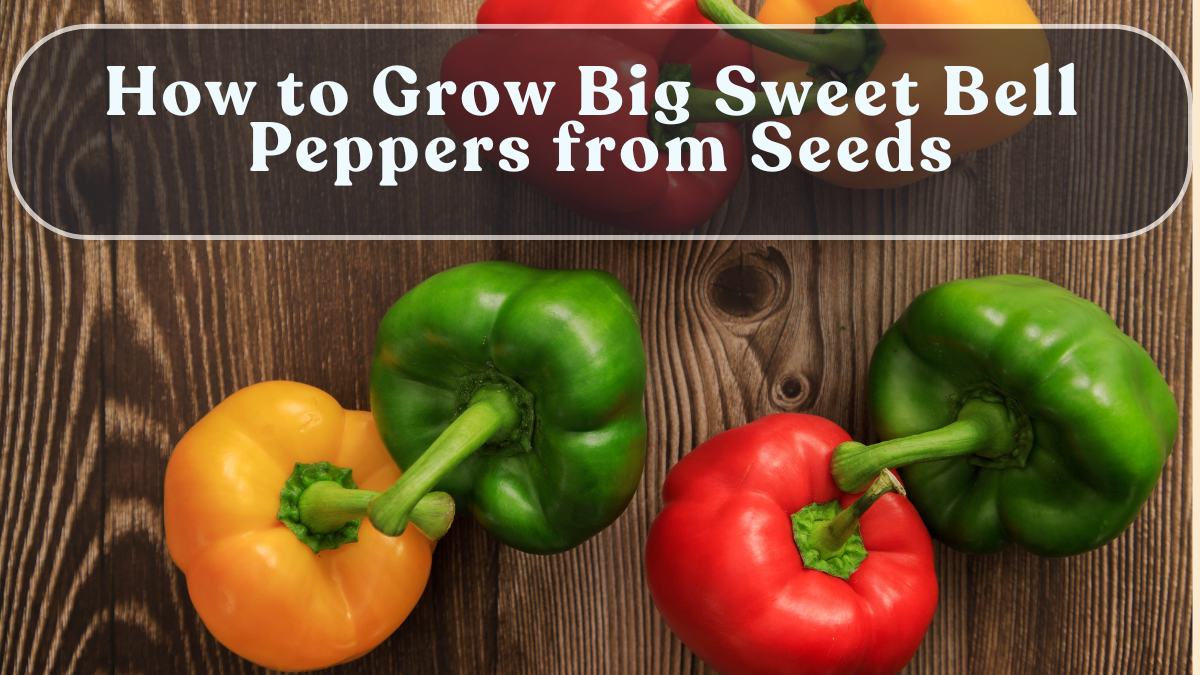Growing big, sweet bell peppers from seeds at home is easier than it looks—once you understand the right soil mix, sunlight, and feeding routine. Bell peppers (or capsicum) are warm-season plants that thrive in pots, garden beds, and even balconies. With proper care, you can grow vibrant red, yellow, or green peppers that are not only colorful but packed with vitamin C, antioxidants, and fiber.
Here’s a simple step-by-step guide to help you produce plump, juicy bell peppers right from your home garden.

Selecting and Preparing Seeds
Start with high-quality hybrid or organic bell pepper seeds. You can save seeds from a store-bought pepper, but hybrids often yield better results in terms of size and taste.
-
Soak the seeds in lukewarm water for 6–8 hours before sowing to speed up germination.
-
Use a seed tray or small pots filled with a fine soil mix.
-
Sow each seed about ¼ inch deep, and lightly cover it with soil.
-
Keep the tray in a warm, bright area (around 25–30°C).
Seeds will germinate in 7–10 days, and seedlings will be ready for transplanting within 4–5 weeks once they have at least 4 true leaves.
Preparing the Soil Mix
Bell peppers love light, well-draining, and nutrient-rich soil. A good homemade mix includes:
-
40% garden soil
-
30% compost or cow dung manure
-
20% cocopeat or peat moss
-
10% sand or perlite for aeration
Mix in wood ash or bone meal to boost calcium and phosphorus—key nutrients for bigger, thicker fruits. Ensure the soil remains slightly moist but never soggy.
Transplanting and Spacing
Transplant your seedlings into pots or garden beds after 4–5 weeks.
-
Use pots at least 12–14 inches deep with drainage holes.
-
Maintain 18 inches of spacing between plants in beds.
-
Water immediately after transplanting to help the roots settle.
For best results, place the plants in a sunny spot receiving 6–8 hours of direct sunlight daily.
Watering and Feeding Routine
Peppers require consistent watering but can’t tolerate waterlogging.
-
Water the plants when the top 1 inch of soil feels dry.
-
Avoid splashing water on the leaves to reduce fungal problems.
-
During fruiting, reduce watering slightly to improve flavor and thickness.
Feed the plants every 15 days with organic fertilizers like vermicompost, compost tea, or seaweed extract. Once flowers appear, switch to a phosphorus and potassium-rich fertilizer (like banana peel compost or bone meal) to promote large fruit development.
Pruning and Support
Pruning helps the plant focus energy on fruit production instead of unnecessary leaves.
-
Pinch the growing tips when plants reach about 12 inches tall to encourage branching.
-
Remove yellow or lower leaves to improve airflow.
-
Support the plant using stakes or bamboo sticks, especially when it starts bearing heavy fruits.
Proper pruning and staking prevent breakage and ensure better sunlight exposure to developing peppers.
Pest and Disease Care
Common pepper pests include aphids, whiteflies, and spider mites. Keep them under control with neem oil sprays once a week. To avoid fungal infections, maintain good drainage and never overwater. Crop rotation and sunlight are your best natural preventives.
Harvesting
Bell peppers are usually ready for harvest 70–90 days after transplanting. Harvest when fruits are firm, glossy, and reach full color.
-
Green peppers can be picked early for continuous flowering.
-
Allowing them to ripen to red or yellow gives sweeter flavor and higher vitamin content.
Use scissors or pruning shears to cut the fruits rather than pulling them, which can damage the plant.
Conclusion
Growing big, sweet bell peppers from seeds is one of the most satisfying gardening experiences. With rich soil, proper sunlight, and regular feeding, you can harvest colorful, crisp peppers right from your balcony or garden.
Whether used in salads, stir-fries, or stuffed dishes, your homegrown bell peppers will taste fresher and sweeter than anything from the market—proof that even a few pots can yield big, flavorful rewards.
FAQs
How long does it take to grow bell peppers from seeds?
It takes about 90 days from sowing to harvest, depending on climate and variety.
Can bell peppers grow indoors?
Yes, they grow well indoors with 6–8 hours of sunlight or under LED grow lights.
How do I make my bell peppers bigger?
Use phosphorus-rich fertilizers, prune regularly, and maintain even watering to promote larger fruit.
What causes flowers to fall off pepper plants?
It’s often due to overwatering, temperature stress, or nutrient imbalance. Ensure balanced feeding and stable conditions.
How often should I fertilize bell pepper plants?
Feed every 15 days with organic liquid fertilizer and top-dress with compost monthly for steady growth.
